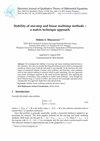Periodic solution of a bioeconomic fishery model by coincidence degree theory
IF 0.8
4区 数学
Q1 MATHEMATICS
Electronic Journal of Qualitative Theory of Differential Equations
Pub Date : 2023-01-01
DOI:10.14232/ejqtde.2023.1.29
引用次数: 0
Abstract
用重合度理论求解生物经济渔业模型的周期解
在这篇文章中,我们用确定的方法研究了在燃烧动力学中遵循生物经济模型的积极本质解决方案− n K ) − q ( t ) E n + D ) ,d E d t = E ( A ( t ) q ( t ) α ( t) n n + D − q 2 ( t ) α ( t )n 2 E ( n + D ) 2 − c ( t ) ) , 那里的functions r,q, A, c和α是挑战积极T-periodic functions。这是一个价格均值的模型,代表着美国唯一一个价值$n的网站,而t代表鱼的海洋。Examples会得到我们的激励。
本文章由计算机程序翻译,如有差异,请以英文原文为准。
求助全文
约1分钟内获得全文
求助全文
来源期刊
CiteScore
1.40
自引率
9.10%
发文量
23
审稿时长
3 months
期刊介绍:
The Electronic Journal of Qualitative Theory of Differential Equations (EJQTDE) is a completely open access journal dedicated to bringing you high quality papers on the qualitative theory of differential equations. Papers appearing in EJQTDE are available in PDF format that can be previewed, or downloaded to your computer. The EJQTDE is covered by the Mathematical Reviews, Zentralblatt and Scopus. It is also selected for coverage in Thomson Reuters products and custom information services, which means that its content is indexed in Science Citation Index, Current Contents and Journal Citation Reports. Our journal has an impact factor of 1.827, and the International Standard Serial Number HU ISSN 1417-3875.
All topics related to the qualitative theory (stability, periodicity, boundedness, etc.) of differential equations (ODE''s, PDE''s, integral equations, functional differential equations, etc.) and their applications will be considered for publication. Research articles are refereed under the same standards as those used by any journal covered by the Mathematical Reviews or the Zentralblatt (blind peer review). Long papers and proceedings of conferences are accepted as monographs at the discretion of the editors.

 求助内容:
求助内容: 应助结果提醒方式:
应助结果提醒方式:


